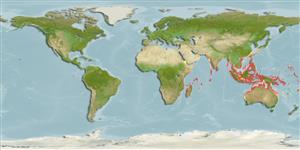Environment: milieu / climate zone / depth range / distribution range
Écologie
marin récifal; profondeur 1 - 30 m (Ref. 9710). Tropical
Indo-West Pacific: Maldives, India, Sri Lanka, Andaman Sea and the westernmost portion of the Indo-Malayan Archipelago.
Taille / Poids / Âge
Maturity: Lm ? range ? - ? cm
Max length : 20.0 cm TL mâle / non sexé; (Ref. 4858)
Épines dorsales (Total) : 13; Rayons mous dorsaux (Total) : 24 - 25; Épines anales: 3; Rayons mous anaux: 20 - 21.
Found on rich coral reefs, also on rubble and rocky areas. Adults in pairs, juveniles solitary. Closely related to C. vagabundus (Ref. 48636). Home ranging (Ref. 90102). Feeds largely on algae and coral polyps, but captive ones will accept a wide variety of food. Oviparous (Ref. 205). Form pairs during breeding (Ref. 205). Excellent aquarium fish.
Life cycle and mating behavior
Maturities | Reproduction | Spawnings | Egg(s) | Fecundities | Larves
Form pairs during breeding (Ref. 205).
Allen, G.R., 1985. Butterfly and angelfishes of the world. Vol. 2. 3rd edit. in English. Mergus Publishers, Melle, Germany. (Ref. 4858)
Statut dans la liste rouge de l'IUCN (Ref. 130435)
Menace pour l'homme
Harmless
Utilisations par l'homme
Pêcheries: commercial; Aquarium: Commercial
Outils
Articles particuliers
Télécharger en XML
Sources Internet
Estimates based on models
Preferred temperature (Ref.
123201): 25.4 - 29.2, mean 28.6 °C (based on 2239 cells).
Phylogenetic diversity index (Ref.
82804): PD
50 = 0.5000 [Uniqueness, from 0.5 = low to 2.0 = high].
Bayesian length-weight: a=0.01318 (0.00777 - 0.02235), b=2.88 (2.73 - 3.03), in cm total length, based on LWR estimates for this species & Genus-body shape (Ref.
93245).
Niveau trophique (Ref.
69278): 2.6 ±0.40 se; based on food items.
Résilience (Ref.
120179): Haut, temps minimum de doublement de population inférieur à 15 mois (Preliminary K or Fecundity.).
Fishing Vulnerability (Ref.
59153): Low vulnerability (10 of 100).
Nutrients (Ref.
124155): Calcium = 93.9 [48.9, 145.2] mg/100g; Iron = 0.799 [0.489, 1.285] mg/100g; Protein = 18.4 [17.2, 19.5] %; Omega3 = 0.105 [0.066, 0.165] g/100g; Selenium = 33.3 [18.8, 62.0] μg/100g; VitaminA = 43.2 [12.1, 150.1] μg/100g; Zinc = 1.54 [1.05, 2.21] mg/100g (wet weight);
